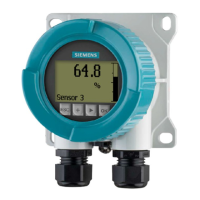15
MAN-100472 RD150 - Operating Instructions
57030-EN-180717
5 Connecting to power supply
5.1 Preparing the connection
Always keep in mind the following safety instructions:
•
Carry out electrical connection by trained personnel authorised by
the plant operator
•
If overvoltage surges are expected, overvoltage arresters should
be installed
Warning:
Connect only in the complete absence of line voltage.
Power supply and current signal are carried on the same two-wire
cable.Thevoltagesupplyrangecandierdependingonthesensor.
Thedataforpowersupplyarespeciedinchapter"Technical data".
Make sure that the supply circuits are separated from the mains
circuits and of an energy-limited voltage supply, e.g. of "Class 2" (acc.
to UL 1310, NEC 725 or CAN/CSA C22.2 No. 223), according to inter-
nationallyharmonizedstandardIEC61010-1.
Keepinmindthefollowingadditionalfactorsthatinuencetheoperat-
ing voltage:
•
Output voltage of the power supply unit can be lower under nomi-
nal load (with a sensor current of 20.5 mA resp. 22 mA in case of
fault message)
•
Voltage loss on the RD150 (see supply circuit in chapter "Techni-
cal data")
Youcanndinformationontheloadresistanceinchapter"Technical
data", (voltage supply of the respective sensor)
The instrument is connected with standard two-wire cable without
screen. If electromagnetic interference is expected which is above the
test values of EN 61326-1 for industrial areas, screened cable should
be used.
We generally recommend the use of screened cable for HART mode.
Usecablewithroundcross-section.Toensurethesealeectofthe
cablegland(IPprotectionrating),ndoutwhichcableouterdiameter
thecableglandissuitablefor.Useacableglandttingthecable
diameter.
Youcanndanoverviewofthecableglandsinchapter"Technical
data".
Metric threads
In the case of instrument housings with metric thread, the cable
glands are screwed in at the factory. They are sealed with plastic
plugs as transport protection.
You have to remove these plugs before electrical connection.
Safety instructions
Voltage supply
Connection cable
Cable glands

